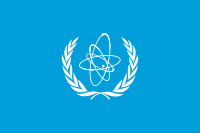Media often refer to the IAEA as "the UN's Nuclear Watchdog". While this describes one of the Agency's roles, it is by no means the only one.
The IAEA has its headquarters in Vienna, Austria. Two "Regional Safeguards Offices" are located in Toronto, Canada; and Tokyo, Japan. The IAEA has two liaison offices, located in New York, USA; and Geneva, Switzerland. In addition, it has laboratories in Seibersdorf and Vienna, Austria; Monaco; and Trieste, Italy.
| International Atomic Energy Agency | |
| Formation | 1957 |
|---|---|
| Headquarters | Vienna, Austria |
| Membership | 144 member states |
| Official languages | Arabic, Chinese, English, French, Russian and Spanish |
| Secretary General | Mohamed ElBaradei |
| Website | http://www.iaea.org |
History
The IAEA serves as an intergovernmental forum for scientific and technical co-operation in the peaceful use of nuclear technology worldwide. The IAEA's programmes encourage the development of the peaceful applications of nuclear technology, provide international safeguards against its misuse, and facilitate the application of safety measures in its use. IAEA expanded its nuclear safety efforts in response to the Chernobyl disaster in 1986.
The IAEA was headed by Hans Blix from 1981 to 1997. The current head of the organization is the Egyptian Mohamed ElBaradei. At the 49th General Conference, ElBaradei was confirmed as Director General until 2009.
The IAEA's mission is guided by the interests and needs of Member States, strategic plans and the vision embodied in the IAEA Statute (see below). Three main pillars - or areas of work - underpin the IAEA's mission: Safety and Security; Science and Technology; and Safeguards and Verification.
The Agency and Director General Mohamed ElBaradei were awarded the Nobel Peace Prize in 2005. In Dr. ElBaradei's speech he stated that only 1% of the money spent on developing new weapons would be enough to feed the entire world and that, if we hope to escape self-destruction, then nuclear weapons should have no place in our collective conscience, and no role in our security. Nobel Lecture.
[edit] Structure and function
The IAEA is a specialized agency of the United Nations (UN). The IAEA is not under direct control of any UN body, but reports to both the General Assembly and the Security Council. The IAEA’s structure and function is defined by its founding document: the IAEA’s Statute (see below). The IAEA has three main bodies: the Board of Governors, the General Conference, and the Secretariat.
The Board of Governors is one of two policy making bodies of the IAEA. The Board consists of 13 members designated by the outgoing Board and 22 members elected by the General Conference. The outgoing Board designates the ten members who are the most advanced in atomic energy technology and the remaining three most advanced members from any of the following areas that are not represented by the first ten: North America, Latin America, Western Europe, Eastern Europe, Africa, Middle East and South Asia, South East Asia, the Pacific, and the Far East. These members are designated for one year terms. The General Conference elects 22 members from the remaining nations to two year terms. Eleven are elected each year. The 22 elected members must also represent a stipulated geographic diversity (Statute). The current Board members are: Argentina, Australia, Austria, Belarus, Bolivia, Brazil, Canada, Chile, the People's Republic of China, Colombia, Croatia, Cuba, Egypt, Ethiopia, Finland, France, Germany, Greece, India, Indonesia, Japan, Libya, Morocco, Nigeria, Norway, Pakistan, Republic of Korea, Russian Federation, Slovenia, South Africa, Sweden, Syria, Thailand, United Kingdom, United States of America, (IAEA Board of Governors 2006–2007).
The Board, in its five yearly meetings, is responsible for making most of the policy of the IAEA. The Board makes recommendations to the General Conference on IAEA activities and budget, is responsible for publishing IAEA standards and appoints the Director General subject to General Conference approval (IAEA Fundamentals 2005). Board members each receive one vote. Budget matters require a two-thirds majority. All other matters require only a simple majority. The simple majority also has the power to stipulate issues that will thereafter require a two-thirds majority. Two-thirds of all Board members must be present to call a vote (IAEA Board of Governors 1989).
The General Conference (GC) is the IAEA’s lesser policy making body. The GC is made up of all 144 member states. The GC meets once a year, in September, to approve the actions and budgets passed on from the Board of Governors. The GC also approves the nominee for Director General and requests reports from the Board on issues in question (Statute). Each member receives one vote. Issues of budget, Statute amendment and suspension of a member’s privileges require a two- thirds majority and all other issues require a simple majority. Similar to the Board, the GC can, by simple majority, designate issues to require a two- thirds majority. The GC elects a President at each annual in order to facilitate an effective meeting. The President only serves for the duration of the session (Statute).
The main function of the GC is to serve as a forum for debate on current issues and policies. Any of the other IAEA organs, the Director General, the Board and member states can table issues to be discussed by the GC (IAEA Fundamentals 2005). This function of the GC is almost identical to the General Assembly of the United Nations.
The Secretariat is the professional and general service staff of the IAEA. The Secretariat is headed by the Director General. The Director General, currently Dr. Mohamed ElBaradei, is responsible for enforcement of the actions passed by the Board of Governors and the GC. The Director General is selected by the Board and approved by the GC for renewable four year terms. The Director General oversees six departments that do the actual work in carrying out the policies of the IAEA: Nuclear Energy, Nuclear Safety and Security, Nuclear Sciences and Applications, Safeguards, Technical Cooperation, and Management. Dr. ElBaradei, together with the IAEA as an institution, won the 2005 Nobel Peace Prize.
The IAEA budget is two-part. The regular budget funds most activities of the IAEA and is assessed to each member nation ($290 million in 2006). The Technical Cooperation Fund is funded by voluntary contributions with a general target in the $80 million range.
The process of joining the IAEA is fairly simple. A State must notify the Director General of its desire to join. The Director then submits the request to the Board for consideration. If the State is approved by the Board, the GC must then consider the State. When the State receives final approval for membership, it must then submit its signed acceptance of the IAEA’s Statute. The State is considered a member when its acceptance letter is deposited; the IAEA’s other members are subsequently notified of the new member.
The IAEA exists to pursue “safe, secure and peaceful uses of nuclear sciences and technology” (Pillars 2005). The IAEA pursues this mission with three main functions: inspections of existing nuclear facilities to ensure peaceful use, information and standards to ensure the stability of nuclear facilities, and as a hub for the sciences seeking peaceful applications of nuclear technology.
[edit] Membership
The Vatican City and many of the UN members are parties of the IAEA.
Not participating are:
 Andorra
Andorra Antigua and Barbuda
Antigua and Barbuda Bahamas
Bahamas Bahrain
Bahrain Barbados
Barbados Bhutan
Bhutan Burundi
Burundi Cape Verde
Cape Verde Comoros
Comoros Dominica
Dominica Equatorial Guinea
Equatorial Guinea Fiji
Fiji Gambia
Gambia Grenada
Grenada Guinea
Guinea Guinea-Bissau
Guinea-Bissau Guyana
Guyana Kiribati
Kiribati Israel
Israel Laos
Laos Lesotho
Lesotho Maldives
Maldives Micronesia
Micronesia Nauru
Nauru Nepal
Nepal Oman
Oman Papua New Guinea
Papua New Guinea Republic of the Congo
Republic of the Congo Rwanda
Rwanda San Marino
San Marino Saint Kitts and Nevis
Saint Kitts and Nevis Saint Lucia
Saint Lucia Saint Vincent and the Grenadines
Saint Vincent and the Grenadines Samoa
Samoa São Tomé and Príncipe
São Tomé and Príncipe Solomon Islands
Solomon Islands Somalia
Somalia Suriname
Suriname Swaziland
Swaziland Timor-Leste
Timor-Leste Tonga
Tonga Trinidad and Tobago
Trinidad and Tobago Turkmenistan
Turkmenistan Tuvalu
Tuvalu Vanuatu
Vanuatu
Countries that have withdrawn from the IAEA are:
 Cambodia (1958–2003)
Cambodia (1958–2003) North Korea (1974–1994)
North Korea (1974–1994)
Countries that have not yet finalized ratification of their accession documents:
 Togo (2004)
Togo (2004)
Other entities not represented at the IAEA (ineligible due to not being recognised as independent countries):
[edit] IAEA and Iran
In February 2003 Mohamed ElBaradei traveled to Iran with a team of inspectors to investigate Iran's nuclear program . In November 2003 Dr. ElBaradei reported to the Board of Governors that Iran had repeatedly and over an extended period failed to meet with its safeguards obligations, including by failing to declare its uranium enrichment program. [1]. Although he stated that there was "no evidence" that Iran was pursuing nuclear weapons, he added that he was "still not in a position to conclude that there are no undeclared nuclear materials or activities in Iran." [2] On December 18, 2003 Iran signed the Additional Protocol at the IAEA headquarters in Vienna, and pledged to act in accord with its provisions pending completion of ratification of the protocol. [3]. Iran also pledged to suspend its plutonium reprocessing and uranium enrichment-related activities, in response to a diplomatic initiative by France, Germany and the UK. [4] [5] However, Iran ended its suspension and ended implementation of the Additional Protocol on August 1, 2005. [6]
On September 24, 2005, the Board of Governors, acting under Article XII.C of the IAEA Statute, found that Iran’s failures to meet its safeguards obligations constituted non-compliance with Iran's NPT Safeguards agreement. [7] On February 4, 2006 the Board of the International Atomic Energy Agency requested the Director General to make a report concerning Iran to the United Nations Security Council following the March 2006 meeting of the IAEA Board. This resolution was decided by a vote of 27-3 (27 Board members voted for the resolution, 3, Cuba, Syria and Venezuela, voted against the resolution, and the remaining 5, Algeria, Libya, Indonesia, South Africa and Belarus, abstained). [8]
On December 23, 2006, the UN Security Council passed a resolution [9] requiring Iran to suspend its uranium enrichment activities and requiring all UN members and the IAEA to impose certain sanctions on Iran. In January 2007 IAEA Director General Mohamed ElBaradei proposed a "time out", that Iran suspend enrichment related activity and the United Nations Security Council suspend sanctions simultaneously, with the aim to revive stalled negotiations. At its March 2007 meeting, the Board of Governors agreed to curtail Technical Cooperation activities with Iran, as recommended in the Director General's February 9 report. [10]
However, on September 7, 2007, ElBaradei argued against military action, saying: "We have not seen any weaponization of their program, nor have we received any information to that effect - no smoking gun or information from intelligence. Based on the evidence we have, we do not see ... a clear and present danger that requires that you go beyond diplomacy." [11]






